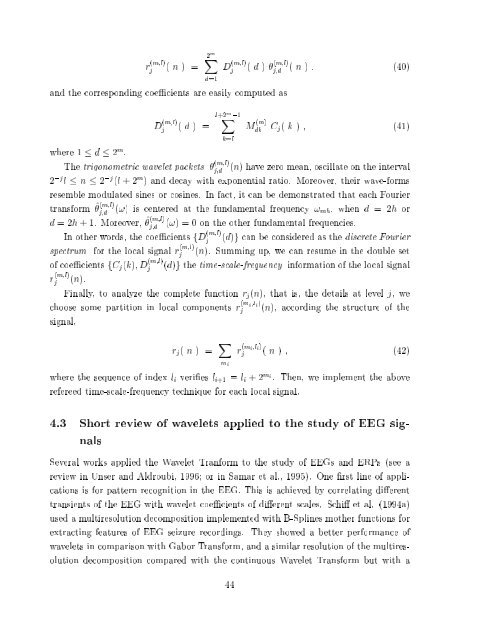Quantitative analysis of EEG signals: Time-frequency methods and ...
Quantitative analysis of EEG signals: Time-frequency methods and ...
Quantitative analysis of EEG signals: Time-frequency methods and ...
Create successful ePaper yourself
Turn your PDF publications into a flip-book with our unique Google optimized e-Paper software.
(ml)<br />
j ( n ) =<br />
2 m X<br />
d=1<br />
<strong>and</strong> the corresponding coecients are easily computed as<br />
where 1 d 2 m .<br />
D (ml)<br />
j ( d ) =<br />
D (ml)<br />
j ( d ) (ml)<br />
jd<br />
( n ) : (40)<br />
l+2 m ;1<br />
X<br />
k=l<br />
M (m)<br />
dk<br />
C j ( k ) (41)<br />
The trigonometric wavelet packets (ml)<br />
jd<br />
(n) have zero mean, oscillate on the interval<br />
2 ;j l n 2 ;j (l +2 m ) <strong>and</strong> decay with exponential ratio. Moreover, their wave-forms<br />
resemble modulated sines or cosines. In fact, it can be demonstrated that each Fourier<br />
(ml)<br />
transform ^<br />
jd<br />
(!) is centered at the fundamental <strong>frequency</strong> ! mh , when d = 2h or<br />
(ml)<br />
d =2h +1. Moreover, ^ jd (!) =0on the other fundamental frequencies.<br />
In other words, the coecients fD (ml)<br />
j<br />
spectrum<br />
for the local signal r (ml)<br />
j<br />
<strong>of</strong> coecients fC j (k)D (ml)<br />
j<br />
(d)g can be considered as the discrete Fourier<br />
(n). Summing up, we can resume in the double set<br />
(d)g the time-scale-<strong>frequency</strong> information <strong>of</strong> the local signal<br />
r (ml)<br />
j (n).<br />
Finally, to analyze the complete function r j (n), that is, the details at level j, we<br />
choose some partition in local components r (m il i )<br />
j (n), according the structure <strong>of</strong> the<br />
signal,<br />
r j ( n ) = X m i<br />
r (m il i )<br />
j ( n ) (42)<br />
where the sequence <strong>of</strong> index l i veries l i+1 = l i +2 m i<br />
. Then, we implement the above<br />
refereed time-scale-<strong>frequency</strong> technique for each local signal.<br />
4.3 Short review <strong>of</strong> wavelets applied to the study <strong>of</strong> <strong>EEG</strong> <strong>signals</strong><br />
Several works applied the Wavelet Tranform to the study <strong>of</strong> <strong>EEG</strong>s <strong>and</strong> ERPs (see a<br />
review in Unser <strong>and</strong> Aldroubi, 1996 or in Samar et al., 1995). One rst line <strong>of</strong> applications<br />
is for pattern recognition in the <strong>EEG</strong>. This is achieved by correlating dierent<br />
transients <strong>of</strong> the <strong>EEG</strong> with wavelet coecients <strong>of</strong> dierent scales. Schi et al. (1994a)<br />
used amultiresolution decomposition implemented with B-Splines mother functions for<br />
extracting features <strong>of</strong> <strong>EEG</strong> seizure recordings. They showed a better performance <strong>of</strong><br />
wavelets in comparison with Gabor Transform, <strong>and</strong> a similar resolution <strong>of</strong> the multiresolution<br />
decomposition compared with the continuous Wavelet Transform but with a<br />
44




